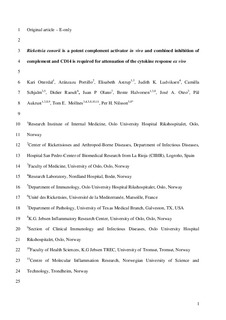| dc.contributor.author | Otterdal, Kari | |
| dc.contributor.author | Portillo, Aránzazu | |
| dc.contributor.author | Astrup, Elisabeth | |
| dc.contributor.author | Ludviksen, Judith K | |
| dc.contributor.author | Schjalm, Camilla | |
| dc.contributor.author | Raoult, Didier | |
| dc.contributor.author | Olano, Juan Pablo | |
| dc.contributor.author | Halvorsen, Bente | |
| dc.contributor.author | Oteo Revuelta, José Antonio | |
| dc.contributor.author | Aukrust, Pål | |
| dc.contributor.author | Mollnes, Tom Eirik | |
| dc.contributor.author | Nilsson, Per | |
| dc.date.accessioned | 2017-10-24T11:14:28Z | |
| dc.date.available | 2017-10-24T11:14:28Z | |
| dc.date.created | 2016-11-24T09:10:39Z | |
| dc.date.issued | 2016 | |
| dc.identifier.citation | Clinical Microbiology and Infection. 2016, 22 (8), 734.e1-734.e6. | nb_NO |
| dc.identifier.issn | 1198-743X | |
| dc.identifier.uri | http://hdl.handle.net/11250/2461767 | |
| dc.description.abstract | Mediterranean spotted fever caused by Rickettsia conorii is a potentially lethal disease characterized by vascular inflammation affecting multiple organs. Studies of R. conorii so far have focused on activation of inflammatory cells and their release of inflammatory cytokines, but complement activation has not been investigated in R. conorii-infected patients. Here, we performed a comprehensive analysis of complement activation markers and the soluble cross-talking co-receptor CD14 (sCD14) in plasma from R. conorii-infected patients. The clinical data were supplemented with ex vivo experiments where the cytokine response was characterized in human whole blood stimulated with R. conorii. Complement activation markers at the level of C3 (C3bc, C3bBbP) and terminal pathway activation (sC5b-9), as well as sCD14, were markedly elevated (p <0.01 for all), and closely correlated (p <0.05 for all), in patients at admission compared with healthy matched controls. All tested markers were significantly reduced to baseline values at time of follow up. Rickettsia conorii incubated in human whole blood was shown to trigger complement activation accompanied by release of the inflammatory cytokines interleukin-1β (IL-1β), IL-6, IL-8 and tumour necrosis factor. Whereas inhibition of either C3 or CD14 had only a minor effect on released cytokines, combined inhibition of C3 and CD14 resulted in significant reduction, virtually to baseline levels, of the four cytokines (p <0.05 for all). Our data show that complement is markedly activated upon R. conorii infection and complement activation is, together with CD14, responsible for a major part of the cytokine response induced by R. conorii in human whole blood. | nb_NO |
| dc.language.iso | eng | nb_NO |
| dc.publisher | Elsevier | nb_NO |
| dc.title | Rickettsia conorii is a potent complement activator in vivo and combined inhibition of complement and CD14 is required for attenuation of the cytokine response ex vivo | nb_NO |
| dc.type | Journal article | nb_NO |
| dc.description.version | submittedVersion | nb_NO |
| dc.source.pagenumber | 734.e1-734.e6 | nb_NO |
| dc.source.volume | 22 | nb_NO |
| dc.source.journal | Clinical Microbiology and Infection | nb_NO |
| dc.source.issue | 8 | nb_NO |
| dc.identifier.doi | 10.1016/j.cmi.2016.05.010 | |
| dc.identifier.cristin | 1403635 | |
| dc.relation.project | Norges forskningsråd: 223255 | nb_NO |
| dc.description.localcode | This is a submitted manuscript of an article published by Elsevier Ltd in Clinical Microbiology and Infection, 20 May 2016 | nb_NO |
| cristin.unitcode | 194,65,15,30 | |
| cristin.unitcode | 194,65,15,0 | |
| cristin.unitname | Centre of Molecular Inflammation Research (SFF-CEMIR) | |
| cristin.unitname | Institutt for kreftforskning og molekylær medisin | |
| cristin.ispublished | true | |
| cristin.fulltext | original | |
| cristin.qualitycode | 1 | |
